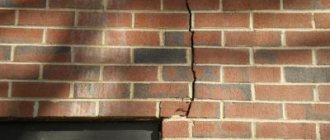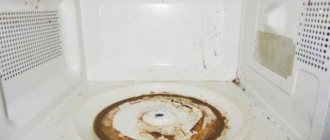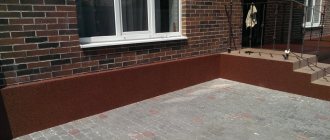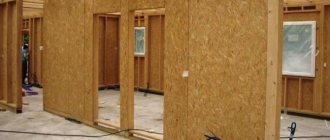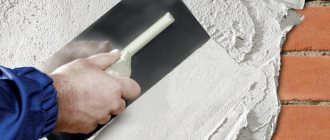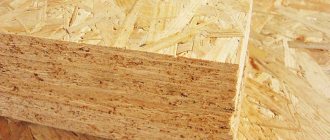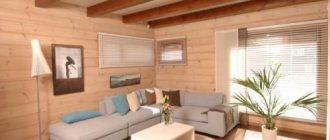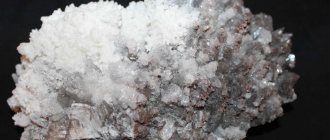Oriented strand boards are in wide demand in private housing construction due to their good technical and operational characteristics and affordability. They have found application in interior and exterior decoration. To make the slabs aesthetically pleasing, OSB painting is often used. Let's figure out how to choose paint and decorate the cladding with your own hands.
The need to paint OSB panels
OSB boards are a practical and inexpensive option for covering the internal surfaces of a room and external walls of a house. However, the untreated coating looks aesthetically unattractive and requires decorative finishing. Is it possible to paint OSB boards? The unequivocal answer is yes. It is a fast and affordable solution for exterior coating conversion and protection.
Advantages of painting OSB panels:
- a wide selection of colors and paint application techniques - the surface can be given absolutely any look , combining shades and textures at your discretion;
- ease of processing - special skills and expensive equipment are not required;
- maintainability – the damaged area just needs to be repainted;
- possibility of numerous processing - a boring color can be changed to a new one;
- increasing the service life of OSB - some compounds protect panels from ultraviolet radiation and moisture;
- Possibility of cleaning the coating – painted surfaces can be wet cleaned.
The use of paint allows you to disguise the unsightly texture of OSB boards. However, some seek to emphasize or shade the wood grain using stain and varnish.
Features of painting wood boards
When thinking about how to paint OSB panels, you must remember that the material consists of 90% wood . Therefore, most paints intended for woodwork are suitable for painting. However, OSB boards have several features:
- Low adhesive ability. Some compounds do not adhere well to slabs. This is due to the presence of binding components in the panels. Resins do not absorb coloring enamel well.
- Texture of the coating. The surface of the building material is rough and uneven. This feature requires more thorough preparation of the base - grinding is required. In addition, pronounced texture increases paint consumption.
- Age of the slab. The older the OSB sheet, the worse the paint adheres to it. The surface quality of used slabs deteriorates over time, especially if the material has been outdoors. Therefore, it is better not to delay painting and do it immediately after installing the OSB.
For painting, it is better to use polymer-based paints, and it is better to avoid compositions with a water-soluble base - they protect wood boards from moisture less well.
Briefly about the material
Oriented strand board (OSB) consists of 90% natural wood in the form of large chips.
Crushed wood chips are joined together by gluing with different types of resins, polymers and adhesives. The result is a dense and hard material. But, as you know, natural wood is afraid of moisture and can swell under its influence. To protect the boards, they are impregnated with various chemical impregnations. The marking of the slabs depends on the type of impregnation used. Surely you noticed that the abbreviation OSB also has a number in the name. What does it mean?
- OSB-1 – has a minimum level of moisture-proof impregnations in its composition, therefore it is suitable for use only in dry, heated rooms.
- OSB-1 can withstand only short-term and minor exposure to moisture;
- OSB-2 – intended for finishing indoors with an average level of humidity;
- OSB-3 – able to withstand high levels of humidity, and even short-term wetness;
- OSB-4 is the most moisture-resistant category of material. Recommended for outdoor use.
How to paint an OSB board inside a house
When painting OSB boards indoors, it is important to select a non-toxic composition, and also take into account the specific use of the surface being painted.
Possible options:
- acrylic paint;
- stain and varnish;
- glaze azure.
Acrylic paint is considered the best option for interior work . Contains water and acrylates. After application to the surface, the moisture from the paint evaporates, and a protective polymer layer is formed on the OSB board.
Useful: Correct installation of the floor in a frame house
Pros of acrylic paint:
- good adhesion and wear resistance;
- color variety;
- vapor permeability;
- UV resistance, color retention;
- protection of wood boards from damage;
- affordable price.
Acrylic paint can be used to paint the walls and floors of a room. After OSB treatment, the boards acquire a uniform tone.
Combining stain and varnish allows you to preserve the OSB pattern . This method is often used to make the coating original. First, a stain with a patina effect is applied, and then covered with polyurethane or vinyl varnish.
Glazing azure allows you to emphasize the OSB pattern and make the coating wear-resistant. For interior work, flowing acrylic compounds are used. Glaze strengthens the surface and gives the coating a rich shade.
Unusual methods of decoration: patina, stone effect
To give a product made from oriented strand boards an original appearance, you can resort to one of the following decoration options:
- Create an aging effect on the surface.
- Cover the sheets with primer paint. It should be applied with a fur paint roller.
- Cover the walls or ceiling made of OSB with liquid wallpaper. This will not only give the surface an unusual look, but also reduce the emission class of OSB and extend the service life of the finishing coating.
- Apply decorative plaster. This will give the surface relief and create various patterns and designs on it.
- Make bas-reliefs from polyurethane foam or putty composition.
- Decorate the slabs with flexible stone. Work must be performed only on a dry and clean surface using highly elastic adhesives.
I hope the information presented is enough to paint OSB with your own hands in a particular case. In order to master decorating the material, it is useful to watch the following video.
Source
Exterior paints
Paint for exterior use should create a reliable moisture barrier , protect the slabs from exposure to the sun and other negative natural factors.
Experts recommend using thick covering enamels on the outside:
- Silicone. Meet the requirements for facade work - they are water-repellent and resistant to mechanical stress . After processing, they form an elastic layer that does not crack. The disadvantage of silicone paint is its high cost.
- Alkyd. A thin polymer film is formed on the coating, which does not allow moisture to pass through and protects against exposure to UV rays. Alkyd enamels are frost-resistant and suitable for use in regions with harsh climates.
- Latex. The optimal solution for coastal areas. Latex paints are characterized by maximum moisture resistance and good covering ability . Enamel is not demanding on the smoothness of the coating and can withstand many freeze-thaw cycles.
- Oily. The composition is almost not absorbed into the OSB board, so consumption is economical. Important advantages: good adhesion to the coating , durable covering layer. Cons: long drying time, insufficient resistance to water. In regions with high humidity, it is better not to use oil paint.
Acrylic enamels are also suitable for painting the facade. They are moisture resistant, do not fade, and can withstand sudden temperature fluctuations. Their use is permissible at any time of the year, the only condition is that the air temperature is not lower than -20°C.
Recommendations for choosing the right composition
To correctly decide what to paint OSB with, you need to take into account the type of binder of the slab, the expected loads on the surface, and also decide on the decoration method.
General tips to help you make a choice:
- For children's rooms and bedrooms, it is better to use water-based paints - they are environmentally friendly and safe for health.
- In rooms with high humidity, polyurethane compounds based on organic solvents should be used. In combination with resins, such paints create a durable, wear-resistant, washable coating.
- Self-leveling epoxy compounds are suitable for treating the floor and creating a smooth surface
- Alkyd enamels are suitable for painting walls and floors - the paint forms a durable, wear-resistant coating.
Technology of painting OSB boards
Before painting OSB floors or walls, you must carefully prepare the base. The uniformity of paint distribution and the stability of the coating depend on the quality of the work Experts recommend painting after installing OSB boards.
Useful: Ecover: insulation for a wide range of buyers
Surface preparation
The order of work does not depend on what to paint with - alkyd, acrylic or oil composition. The sequence of preparatory actions can be divided into two stages:
- surface cleaning;
- masking seams.
Sanding allows you to smooth out the uneven texture of the slab , hide its texture and ensure uniform coverage of the surface with paint. For work, it is better to use a sander and a medium-grain attachment (P120).
If it is necessary to obtain the smoothest possible coating, then first sand with large grains (P80), and then with fine grains (P200).
To mask seams and screw heads, use elastic putty, special tape or sealant. Work order:
- Clean the seams with a long-bristled brush. For large areas it is better to use a compressor with a thin hose .
- Fill the voids with putty. Seal joints with a width of 5 mm or more with a mixture of putty and sawdust.
- After drying (after 1-2 days), re-treat the surface with a sander.
Base primer
Before painting OSB boards, the surface must be primed. The following can be used as a primer mixture:
- water-based varnish intended for wooden products - acrylic-polyurethane or acrylic composition is diluted with water in a ratio of 1:10;
- alkyd varnish is an affordable alternative to the previous option; Before use, it is advisable to dilute the composition with white spirit;
- Adhesive primer - optimal for light-colored paints , as it protects against visible resin stains on the surface of the finishing layer.
The primer is distributed over the slabs using a roller or brush. Painting begins after the composition has completely dried.
How to coat correctly?
In order for the varnish to adhere well and last a long time, the surface must be prepared for coating. To do this, in some cases it is first necessary to sand the slabs, especially if they are already old or their quality was initially low.
Next comes application. To properly varnish the surface, follow all instructions on the varnish packaging. Each product is individual. Start from the edges and then spread the varnish with a roller over the entire area, with the roller moving in one direction. This is followed by a long drying process. Again, the time will depend on the specific varnish and company, but on average it takes 12 hours. And after that you need to apply another layer in the same way. Wait until it dries and you can use it.
If desired, decoration with colored paints is also allowed. But only after using a primer.
Source
